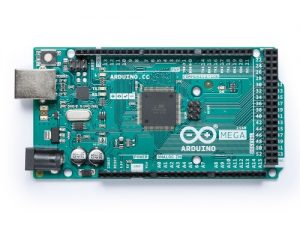

You can supply voltage through this pin, or, if supplying voltage via the power jack, access it through this pin.ĥV. The input voltage to the Arduino board when it's using an external power source (as opposed to 5 volts from the USB connection or other regulated power source). The second one is a not connected pin, that is reserved for future purposes. In future, shields will be compatible both with the board that use the AVR, which operate with 5V and with the Arduino Due that operate with 3.3V. Revision 3 of the board has the following new features:ġ.0 pinout: added SDA and SCL pins that are near to the AREF pin and two other new pins placed near to the RESET pin, the IOREF that allow the shields to adapt to the voltage provided from the board. Revision 2 of the Mega2560 board has a resistor pulling the 8U2 HWB line to ground, making it easier to put into DFU mode. Instead, it features the ATmega16U2 (ATmega8U2 in the revision 1 and revision 2 boards) programmed as a USB-to-serial converter.
ARDUINO MEGA PROJECTS DRIVER
The Mega2560 differs from all preceding boards in that it does not use the FTDI USB-to-serial driver chip.

If using more than 12V, the voltage regulator may overheat and damage the board. If supplied with less than 7V, however, the 5V pin may supply less than five volts and the board may be unstable. The board can operate on an external supply of 6 to 20 volts. Leads from a battery can be inserted in the Gnd and Vin pin headers of the POWER connector. The adapter can be connected by plugging a 2.1mm center-positive plug into the board's power jack. The power source is selected automatically.Įxternal (non-USB) power can come either from an AC-to-DC adapter (wall-wart) or battery. The Arduino Mega can be powered via the USB connection or with an external power supply. The Mega 2560 board is compatible with most shields designed for the Uno and the former boards Duemilanove or Diecimila.ĭigital I/O Pins 54 (of which 14 provide PWM output)įlash Memory 256 KB of which 8 KB used by bootloader It contains everything needed to support the microcontroller simply connect it to a computer with a USB cable or power it with a AC-to-DC adapter or battery to get started.
ARDUINO MEGA PROJECTS SERIAL
It has 54 digital input/output pins (of which 15 can be used as PWM outputs), 16 analog inputs, 4 UARTs (hardware serial ports), a 16 MHz crystal oscillator, a USB connection, a power jack, an ICSP header, and a reset button.

#endif #if defined(_STM32F1_) #define DMA_STM32F1_ //special feature of MAPLE CORE #endif //#define MY_BLUEPILL // MAPLE core has SPI.write(block, n) // ST core has only got SPI.transfer(block, n) // SAMD core might have SPI.transfer(block, n) // SAM core has got SPI.transfer(block, n) // so it is probably safest to have a moderate stack buffer and use transfer //ST core is ok for ILI9341 but not for ST7735X #define CD_COMMAND PIN_LOW(CD_PORT, CD_PIN) #define CD_DATA PIN_HIGH(CD_PORT, CD_PIN) #define CD_OUTPUT PIN_OUTPUT(CD_PORT, CD_PIN) #define CS_ACTIVE PIN_LOW(CS_PORT, CS_PIN) #define CS_IDLE PIN_HIGH(CS_PORT, CS_PIN) #define CS_OUTPUT PIN_OUTPUT(CS_PORT, CS_PIN) #define RESET_ACTIVE PIN_LOW(RESET_PORT, RESET_PIN) #define RESET_IDLE PIN_HIGH(RESET_PORT, RESET_PIN) #define RESET_OUTPUT PIN_OUTPUT(RESET_PORT, RESET_PIN) #define SD_ACTIVE PIN_LOW(SD_PORT, SD_PIN) #define SD_IDLE PIN_HIGH(SD_PORT, SD_PIN) #define SD_OUTPUT PIN_OUTPUT(SD_PORT, SD_PIN) // bit-bang macros for SDIO #define SCK_LO PIN_LOW(SPI_PORT, SCK_PIN) #define SCK_HI PIN_HIGH(SPI_PORT, SCK_PIN) #define SCK_OUT PIN_OUTPUT(SPI_PORT, SCK_PIN) #define MOSI_LO PIN_LOW(SPI_PORT, MOSI_PIN) #define MOSI_HI PIN_HIGH(SPI_PORT, MOSI_PIN) #define MOSI_OUT PIN_OUTPUT(SPI_PORT, MOSI_PIN) #define MOSI_IN PIN_INPUT(SPI_PORT, MOSI_PIN) #define LED_LO PIN_LOW(LED_PORT, LED_PIN) #define LED_HI PIN_HIGH(LED_PORT, LED_PIN) #define LED_OUT PIN_OUTPUT(LED_PORT, LED_PIN) #if defined(USE_SERIAL_COMPLEX) #include "serial_complex.h" #elif defined(_AVR_ATxmega32A4U_) || defined(_AVR_ATxmega128A4U_) #include "serial_xmega.The Arduino Mega 2560 is a microcontroller board based on the ATmega2560.
ARDUINO MEGA PROJECTS CODE
EDITED TO WORK ON THE ARDUINO MEGA #if defined(_AVR_ATmega328P_) & defined(ILI9488_KBV_H_) //#define USE_SERIAL_COMPLEX //optimised C code for Uno, Xmega.


 0 kommentar(er)
0 kommentar(er)
